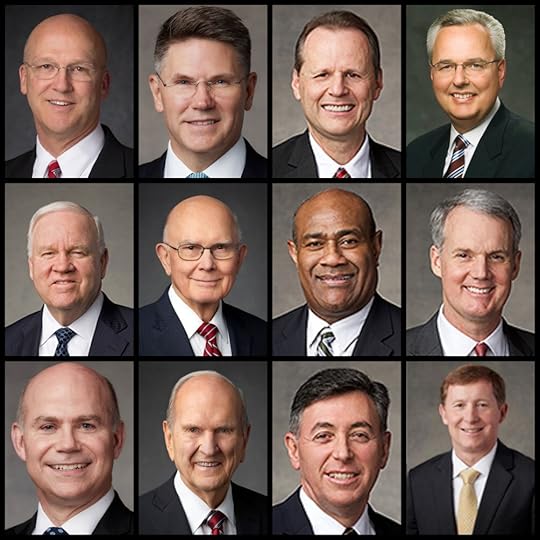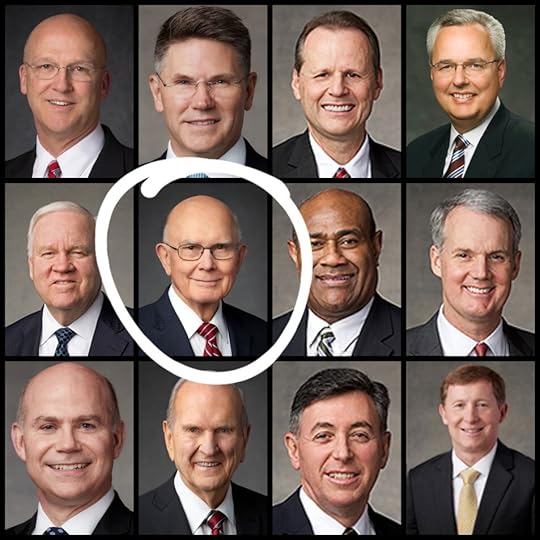Can Anyone Recognize an LDS Female Leader in Public?

Pop quiz question #1: Which of these female church leaders is Bonnie Cordon? What is her calling?

Question #2: Which of these male church leaders is Dallin H. Oaks? What is his calling? (Answers at the end of this post.)
Recently I took my husband to a VIP Christmas event, and while eating hors d’oeuvres I noticed the General Young Women’s President was at the table directly next to ours. (Two years ago I brought him to the same event with me and ended up at the dessert table next to Dallin H. Oaks.)
My husband, an active member of the church, didn’t recognize who we were next to. While I was trying to casually eavesdrop, he kept talking to me. When we stepped away I told him we were next to Bonnie Cordon, and after telling him this he asked me to clarify which woman at the table was her.
Two years ago he’d recognized Dallin H. Oaks from across the room with no help. That night we stood next to one of the top three female leaders in the entire church and he didn’t even notice she was there.
As a woman raising daughters in this culture, I don’t think we should ignore this any longer. I’ve been assured for years that women have value and are respected as leaders, but the average LDS man doesn’t even know who the top one is when he’s standing five feet away from her.
He’s not alone. I’m sure there are millions of other Latter-day Saints who would also stand next to her without recognizing who she was. How could they really, when there are no positions for women at general leadership levels that last longer than five short years? On the contrary, there are many positions for men in leadership that last longer than five years, and male apostles are called for life. There is so much you can do in a lifetime appointment that you can’t do in a five year term, and one of those is become beloved and recognizable to the general membership.
The short tenure for female presidents also means that someone like the General Relief Society President is always newer and relatively inexperienced compared to the majority of male apostles, not to mention the fact that she lacks their lifetime experience of priesthood leadership. She can be released at any time by those presiding men if they become unhappy with the direction she chooses to take her organization in. (In stark contrast, apostles will only be removed from their position due to serious sin.) She will forever be the junior leader, trying to get up to speed and making sure her leadership decisions are palatable to the men in charge. She will have far fewer opportunities to speak in General Conference and this will result in fewer opportunities for her words to be quoted in Sunday School lessons, Sacrament Meeting talks, or lesson manuals.
This hurts us in so many ways we don’t even recognize. Little girls don’t have role models that look like them to learn about. Boys miss out on the opportunity to learn from women and look to them as wise authority figures. Primary rooms are plastered with pictures of apostles and prophets past and present, but rarely hang the female leaders of their own organization. Is a dead male prophet from a hundred years ago really more important to recognize than the image of the living women who run the primary in 2021? I sang songs in primary to memorize all the dead prophet’s names in order and can still sing them to this day – but if my life depended on it I couldn’t tell you one single general primary presidency member from any period of time that I was a child.
This process of ignoring female leadership continued into young adulthood as I took a class at BYU called “Teachings of the Living Prophets”. We spent a semester learning not only their teachings, but memorizing miniscule details about each current apostle and prophet (from their favorite sport to their careers to even how tall they were). Not once did we mention the name of a female leader in the church, and there was no equivalent class to take where you could learn women’s life stories. In all of my years attending Relief Society lessons, never do I recall discussing who a new general president was, despite there being five different women in that position since I was eighteen years old. If as women we don’t even talk about our female leaders, why would the men in the church (like my husband) be any more likely than we are to recognize them? It’s not their fault – it’s a broken system.
At the local level, I was once a counselor in my ward Young Women’s presidency. While I remember who the bishopric, stake president and prophet were at that time, I have no recollection of who the Stake Young Women’s President or General Young Women’s President were at the time. It was priesthood leaders who approved our budgets and activities, sat in on presidency meetings, and spoke at training meetings for us. At the general level, 95 percent of talks I heard were from men. While I do remember meeting with the Stake Young Women’s Presidency when we were first called, our interactions after that point became so nonexistent that I can no longer remember who any of them were. I lived in that same stake for eighteen years and yet I couldn’t have picked them out of a line up again within a year of having met them. (On the other hand, I still see those Bishopric counselors or Stake President every now and then around town and never fail to immediately recognize their faces.)
With all of this cultural baggage, is it any surprise that so few of us have been bothered historically by the complete lack of Heavenly Mother in our teachings, scripture and ongoing revelations? If the women who head the largest female organizations in the church are unknown to us, why would it be strange for the female half of deity to also be invisible? We may theoretically know that a general president or a Mother in Heaven exists – but we don’t know what she looks like, we don’t really communicate much with her, and we could walk right by her in public without recognizing who she was. Heavenly Father is a familiar constant in the lives of Latter-day Saints, but female deity and leadership remains firmly in the shadows.

Answer key: Bonnie Cordon’s picture is in the bottom left corner. Keep in mind that she is one of the top three female leaders in the entire church, and Dallin H. Oaks is one of the top three male leaders in the church. If we are to believe that female leaders are valued equally to male leaders, it should be just as easy for us to recognize her as it is to recognize him.

Dallin H. Oaks. (Did anyone get this wrong?)



